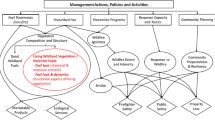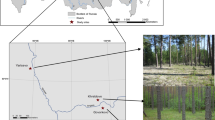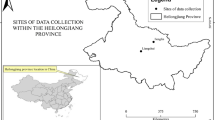Abstract
Characterizing forest fuel properties in terms of their distribution and flammability behaviour offers useful information for effective fire management. Satellite images provide synoptic images capturing the vegetation state and their change including burn area loss, enabling stratification, and narrowing down the search for further investigation on ground or laboratory. The study investigated the flammability of various forest fuels including sal, teak, bamboo and grass species, by analysing different fuel variables such as moisture content (MC), volatile matter (VM), ash content (AC), fixed carbon (FC), higher heating value (HHV) and minimum ignition temperature (MIT), and exploring the intrinsic relationships between and among them. The teak wood showed low MC (5.08%), high VM (81.91%), low AC (1.1%), high HHV (19.93 MJ/kg), high CF (93.82) indicating high sustainability, combustibility and consumability characteristics. Teak indicated higher flammability characteristics compared to sal, while grass indicated higher sustainability and combustibility characteristics compared to bamboo. Overall woody species (sal and teak) indicated high ignitability and sustainability characteristics over grass and bamboo. Among the plant components, leaves indicated high ignitability, wood indicated high sustainability, combustibility and consumability, and barks indicated low flammability characteristics. This study registers a maiden and early attempt using satellite and laboratory-based analysis to characterize the flammability properties of dominant species of tropical dry forests in eastern India.





Similar content being viewed by others
Data availability statement
All the supporting data for the findings of this study are included within this journal paper.
References
Adeleke A, Odusote J, Ikubanni P (2020) The ignitability, fuel ratio and ash fusion temperatures of torrefied woody biomass. Heliyon 6:e03582
Aich S, Nandi BK, Bhattacharya S (2019) Utilization of sal leaves and sal leaves char to improve the combustion performance of reject coal. Energy Sources A Recovery Util Environ Eff 41:2299–2312
Akowuah J, Kemausuor F, Mitchual S (2012) Physico-chemical characteristics and market potential of sawdust charcoal briquette. Int J Energy Environ Eng 3:20
ASTM D1102 (2021) Standard test method for ash in wood. American Society for Testing and Materials, USA. https://www.astm.org/d1102-84r21.html
ASTM D3172 (2021) Standard practice for proximate analysis of coal and coke. American Society For Testing and Materials, USA. https://www.astm.org/d3172-13r21e01.html
ASTM D346 (2019) Standard practice for collection and preparation of coke samples for laboratory analysis. American Society for Testing and Materials, USA. https://www.astm.org/d0346_d0346m-11r19e01.html
ASTM D4442 (2020) Standard test methods for direct moisture content measurement of wood and wood-based materials. American Society for Testing and Materials, USA. https://www.astm.org/d4442-20.html
ASTM E1491 (2019) Standard test method for minimum autoignition temperature of dust clouds. American Society for Testing and Materials, USA. https://www.astm.org/e1491-06r19.html
ASTM E711 (1996) Standard test method for gross calorific value of refuse-derived fuel by the bomb calorimeter. American Society for Testing and Materials, USA. https://www.astm.org/standards/e711
ASTM E871 (2019) Standard method for moisture analysis of particulate wood fuels. American Society for Testing and Materials, USA. https://www.astm.org/standards/e871
ASTM E872 (2019) Standard test method for volatile matter in the analysis of particulate wood fuels. American Society for Testing and Materials, USA. https://www.astm.org/e0872-82r19.html
Bada SO, Falcon RMS, Falcon LM (2014) Investigation of combustion and co-combustion characteristics of raw and thermal treated bamboo with thermal gravimetric analysis. Thermochim Acta 589:207–214
Basu P (2018) Biomass Gasification, Pyrolysis and Torrefaction. Academic Press, Cambridge
Caillat S, Vakkilainen E (2013) Large-scale biomass combustion plants: an overview. In: Rosendahl L (ed) Biomass combustion science, technology and engineering. Woodhead Publishing, Sawston, pp 189–224
Charusiri W, Numcharoenpinij N (2017) Characterization of the optimal catalytic pyrolysis conditions for bio-oil production from brown salwood (Acacia mangium Willd) residues. Biomass Bioenergy 106:127–136
Elehinafe FB, Odunlami OA, Mamudu AO, Akinsanya OO (2021) Investigation of the potentials of southwest Nigerian Napier Grass as an energy source to replace fossils used in firing thermal power plants for air emissions control. Results Eng 11:100259
FSI (2022) Forest fire activities. Forest Survey of India, India. https://fsi.nic.in/forest-fire-activities?pgID=forest-fire-activities
Grammelis P, Margaritis N, Karampinis E (2016) Solid fuel types for energy generation: coal and fossil carbon-derivative solid fuels. In: Oakey J (ed) Fuel flexible energy generation. Woodhead Publishing, Sawston, pp 29–58
Grootemaat S, Wright IJ, Bodegom PM, Cornelissen JHC, Veronica S (2017) Bark traits, decomposition and flammability of Australian forest trees. Aust J Bot 65:327–338
Gupta GK, Gupta PK, Mondal MK (2019) Experimental process parameters optimization and in depth product characterizations for teak sawdust pyrolysis. Waste Manag 87:499–511
Gutsell LS, Johnson EA (2007) Wildfire and tree population processes. In: Edward AJ, Miyanishi K (eds) Plant disturbance ecology. Academic Press, Cambridge, pp 441–485
Ilek A, Siegert CM, Wade A (2021) Hygroscopic contributions to bark water storage and controls exerted by internal bark structure over water vapor absorption. Trees 35:831–843
Jouiad M, Al-Nofeli N, Khalifa N, Benyettou F, Yousef LF (2015) Characteristics of slow pyrolysis biochars produced from rhodes grass and fronds of edible date palm. J Anal Appl Pyrolysis 111:183–190
Kabe T, Ishihara A, Qian E, Sutrisna P, Kabe Y (2004) Coal and coal-related compounds: structures, reactivity and catalytic reactions. Elsevier, Amsterdam
Kumar A (2022) Preserving life on earth, ecosystem-based adaptation. Elsevier, Amsterdam
Kumar RMD, Anand R (2019) Production of biofuel from biomass downdraft gasification and its applications. In: Azad AK, Rasul M (eds) Advanced biofuels. Woodhead Publishing, Sawston, pp 129–151
Kumar M, Gupta RC (1997) Influence of carbonization conditions on the pyrolytic carbon deposition in acacia and eucalyptus wood chars. Energy Sources 13:295–300
Liodakis S, Bakirtzis D, Dimitrakopoulos A (2002) Ignition characteristics of forest species in relation to thermal analysis data. Thermochim Acta 390:83–91
Mi B, Liu Z, Hu W, Wei P, Wei P, Jiang Z, Fei B (2016) Investigating pyrolysis and combustion characteristics of torrefied bamboo, torrefied wood and their blends. Bioresour Technol 209:50–55
Miranda I, Gominho J, Mirra I, Pereira H (2012) Chemical characterization of barks from Picea abies and Pinus sylvestris after fractioning into different particle sizes. Ind Crops Prod 36:395–400
Mishra RK, Mohanty K (2018) Pyrolysis kinetics and thermal behavior of waste sawdust biomass using thermogravimetric analysis. Bioresour Technol 251:63–74
Montoya LTC, Lain S, Issa M, Ilinca A (2021) Renewable energy systems. In: Kabalci E (ed) Hybrid Renewable energy systems and microgrids. Academic Press, Cambridge, pp 103–177
Parr (2010) 455M 6100 calorimeter operating instructions. Parr Instrument Company, USA. https://www.parrinst.com/products/oxygen-bomb-calorimeters/6100-compensated-jacket-calorimeter/documents/
Popović Z, Bojović S, Marković M, Cerdà A (2021) Tree species flammability based on plant traits: a synthesis. Sci Total Environ 800:14962
Rocca GD, Hernando C, Madrigal J, Danti R, Moya J, Guijarro M, Pecchioli A, Moya B (2015) Possible land management uses of common cypress to reduce wildfire initiation risk: a laboratory study. J Environ Manag 159:68–77
Sánchez J, Curt MD, Robert N, Fernández J (2019) The role of bioenergy in the bioeconomy. In: Lago C, Caldés N, Lechón Y (eds) Biomass resources. Academic Press, Cambridge, pp 25–111
Sarkar D (2015) Thermal power plant design and operation. Elsevier, Amsterdam
Senelwa K, Sims R (1999) Fuel characteristics of short rotation forest biomass. Biomass Bioenergy 17:127–140
Sullivan AL (2010) Grassland fire management in future climate. In: Sparks DL (ed) Advances in agronomy. Academic Press, Cambridge, pp 173–208
Thomas P, McAlpine R, Hobson P (2010) Fire in the forest. Cambridge University Press, Cambridge
USDA (2022) Forest fire behavior. Forest Service U.S. Department of Agriculture, USA. https://www.fs.usda.gov/managing-land/fire
Vershinina KY, Shlegel NE, Strizhak PA (2019) Impact of environmentally attractive additives on the ignition delay times of slurry fuels: experimental study. Fuel 238:275–288
Acknowledgements
The authors acknowledge the authority of Department of Mining Engineering and CORAL, Indian Institute of Technology Kharagpur, Kharagpur for providing the required facilities and essential equipment for this study. Satyajit Behera is grateful to the Ministry of Electronics and Information Technology, Government of India for providing financial assistance through the ‘Computational Fluid Dynamics’ project for forest fuel studies.
Author information
Authors and Affiliations
Corresponding author
Rights and permissions
Springer Nature or its licensor (e.g. a society or other partner) holds exclusive rights to this article under a publishing agreement with the author(s) or other rightsholder(s); author self-archiving of the accepted manuscript version of this article is solely governed by the terms of such publishing agreement and applicable law.
About this article
Cite this article
Behera, S., Prusty, B.K., Behera, M.D. et al. Characterizing fuel flammability in a tropical dry community forest in Eastern India using laboratory and remote sensing based approaches. Trop Ecol (2023). https://doi.org/10.1007/s42965-023-00309-6
Received:
Revised:
Accepted:
Published:
DOI: https://doi.org/10.1007/s42965-023-00309-6




